
Jan Brueghelthe Elder was a Flemish painter and draughtsman. He was the son of the eminent Flemish Renaissance painter Pieter Bruegel the Elder. A close friend and frequent collaborator with Peter Paul Rubens, the two artists were the leading Flemish painters in the first three decades of the 17th century.
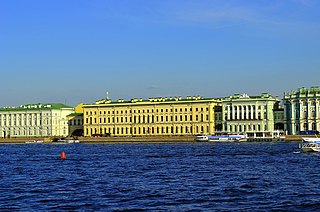
The State Hermitage Museum is a museum of art and culture in Saint Petersburg, Russia. It was founded in 1764 when Empress Catherine the Great acquired a collection of paintings from the Berlin merchant Johann Ernst Gotzkowsky. The museum celebrates the anniversary of its founding each year on 7 December, Saint Catherine's Day. It has been open to the public since 1852. The Art Newspaper ranked the museum 10th in their list of the most visited art museums, with 2,812,913 visitors in 2022.

The Russian Academy of Arts, informally known as the Saint Petersburg Academy of Arts, was an art academy in Saint Petersburg, founded in 1757 by the founder of the Imperial Moscow University Ivan Shuvalov under the name Academy of the Three Noblest Arts. Catherine the Great renamed it the Imperial Academy of Arts and commissioned a new building, completed 25 years later in 1789 by the Neva River. The academy promoted the neoclassical style and technique, and sent its promising students to European capitals for further study. Training at the academy was virtually required for artists to make successful careers.

The Madonna Litta is a late 15th-century painting, traditionally attributed to Leonardo da Vinci, in the Hermitage Museum, Saint Petersburg. It depicts the Virgin Mary breastfeeding the Christ child, a devotional subject known as the Madonna lactans. The figures are set in a dark interior with two arched openings, as in Leonardo's earlier Madonna of the Carnation, and a mountainous landscape in aerial perspective can be seen beyond. In his left hand Christ holds a goldfinch, which is symbolic of his future Passion.
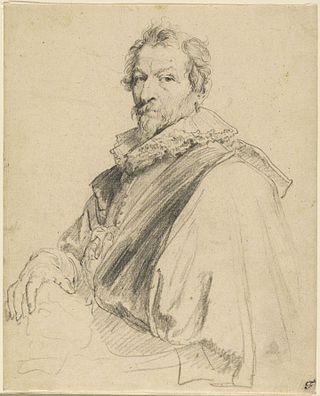
Hendrick van Balen or Hendrick van Balen I was a Flemish Baroque painter and stained glass designer. Hendrick van Balen specialised in small cabinet pictures often painted on a copper support. His favourite themes were mythological and allegorical scenes and, to a lesser extent, religious subjects. The artist played an important role in the renewal of Flemish painting in the early 17th century and was one of the teachers of Anthony van Dyck.

The Soviet sale of Hermitage paintings in 1930 and 1931 resulted in the departure of some of the most valuable paintings from the collection of the State Hermitage Museum in Leningrad to Western museums. Several of the paintings had been in the Hermitage Collection since its creation by Empress Catherine the Great. About 250 paintings were sold, including masterpieces by Jan van Eyck, Titian, Rembrandt, Rubens, Raphael, and other important artists. Andrew Mellon donated the twenty-one paintings he purchased from the Hermitage to the United States government in 1937, which became the nucleus of the National Gallery of Art in Washington, D.C.

Sir Peter Paul Rubens was a Flemish artist and diplomat. He is considered the most influential artist of the Flemish Baroque tradition. Rubens's highly charged compositions reference erudite aspects of classical and Christian history. His unique and immensely popular Baroque style emphasized movement, colour, and sensuality, which followed the immediate, dramatic artistic style promoted in the Counter-Reformation. Rubens was a painter producing altarpieces, portraits, landscapes, and history paintings of mythological and allegorical subjects. He was also a prolific designer of cartoons for the Flemish tapestry workshops and of frontispieces for the publishers in Antwerp.

Susanna and the Elders is a painting by Flemish artist Peter Paul Rubens from 1607. It is housed in the Galleria Borghese in Rome, Italy. There is another version, a youthful work from 1608, in Real Academia de Bellas Artes de San Fernando, in Madrid.
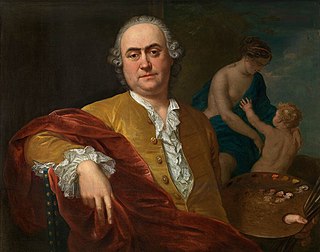
Balthasar Beschey was a Flemish painter, draughtsman and decorative painter of interiors. He started his career as landscape painter but later on switched to history and portrait painting. He played a prominent role in the development of the Academy of Arts in Antwerp and as a teacher.

Yaroslav Levchenko Yury is a Russian artist based in Greece. He is a member of the Japanese Union of Modern Artists, International Association of Art Critics, and heads the International Relations Department at the Mural Department of the Union of Artists of St. Petersburg.

Venus with a Mirror is a painting by Titian, now in the National Gallery of Art in Washington, DC, and it is considered to be one of the collection's highlights.

Perseus and Andromeda is a 1622 painting in the Hermitage Museum by the Flemish artist Peter Paul Rubens of the ancient Greek myth of Perseus and Andromeda after the former's defeat of the Gorgon. The composition is similar to that of an earlier painting by Rubens, Perseus frees Andromeda.

The Stolen Kiss is an oil-on-canvas painting created in 1787, located in the Hermitage Museum, Saint Petersburg. It has been historically attributed to the French Rococo artist Jean-Honoré Fragonard (1732–1806). At 45 by 55 centimetres, the painting is a genre scene influenced by Dutch Golden Age painting, depicting a young couple in a secretive romance, set in the foreground – a subject that was favoured before the French Revolution among French aristocrats.
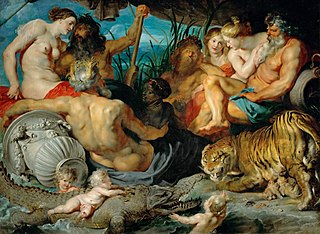
The Four Continents, also known as The Four Rivers of Paradiseor The Four Corners of the World, is a painting by Flemish artist Peter Paul Rubens, made between 1612 and 1615. Rubens painted this piece during a time of truce in the Eighty Years' War known as the Twelve Years' Truce. The painting depicts the female personifications of the four continents with the male personifications of their respective major rivers. The painting also depicts three putti in the foreground along with a crocodile, tigress, and her three cubs. An important figure in this piece is the woman in the middle who personifies Africa. She was one of the two black women Rubens painted at the time.
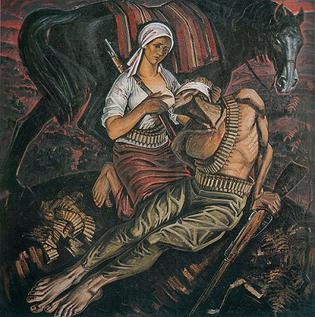
Partisan Ballad is a painting by Belarusian artist Mai Dantsig showing a partisan woman breastfeeding a weary partisan man during World War II. Both are equipped with rifles and ammunition belts. Dantsig borrowed the Roman Charity theme, having seen the eponymous painting by Peter Paul Rubens in the Hermitage Museum. Partisan Ballad alludes to the German occupation of the Soviet Union on the Eastern Front of World War II when Belarusian SSR became the haven of Soviet partisans.

Descent from the Cross is an oil-on-canvas painting of 1600–1602 by the Flemish artist Peter Paul Rubens. It was his first major commissioned work made for the private chapel of Eleonora de’ Medici Gonzaga (1567–1611), duchess of Mantua. The painting remained somewhat obscure until 2001, when it was discovered by German art historian Justus Müller-Hofstede, a specialist on Rubens' early work.

The Guard Room is a 1642 oil-on-panel painting by David Teniers the Younger, now in the Hermitage Museum in St Petersburg. It is signed and dated "David Teniers F. 1642" at the bottom left. Several unsigned but probably autograph variants also survive, such as at the Catherine Palace near St Petersburg and the Walters Art Museum in Baltimore, USA. An early copy by an unknown artist after the Hermitage work is now in the National Museum of Sweden.

Bacchus is a 1638-1640 oil painting of Bacchus by Peter Paul Rubens, now in the Hermitage Museum, in Saint Petersburg, for which it was purchased in 1772. It was originally on a panel support but was transferred to canvas in 1891 by A. Sidorov. An autograph copy of the work is now in the Uffizi in Florence.

Roman Charity is an oil on canvas painting by Peter Paul Rubens, executed c. 1612, now in the Hermitage Museum, in Saint Petersburg, for which it was bought from Koblenz's collection in Brussels in 1768. In 1828 D. A. Smitha of the Hermitage misattributed it as a copy. Later researchers agreed in 1864 and the work was placed in store until 1905, when a re-examination restored its autograph status.

Holy Family, also called The Rest on the Flight into Egypt, is an oil on canvas painting by the French Rococo artist Antoine Watteau, now in the Hermitage Museum, Saint Petersburg. Variously dated between 1714 and 1721, Holy Family is possibly the rarest surviving religious subject in Watteau's art, related to either the Gospel of Matthew, or the Gospel of Pseudo-Matthew; it depicts the Virgin, the Christ Child, and Saint Joseph amid a landscape, surrounded by putti.





















